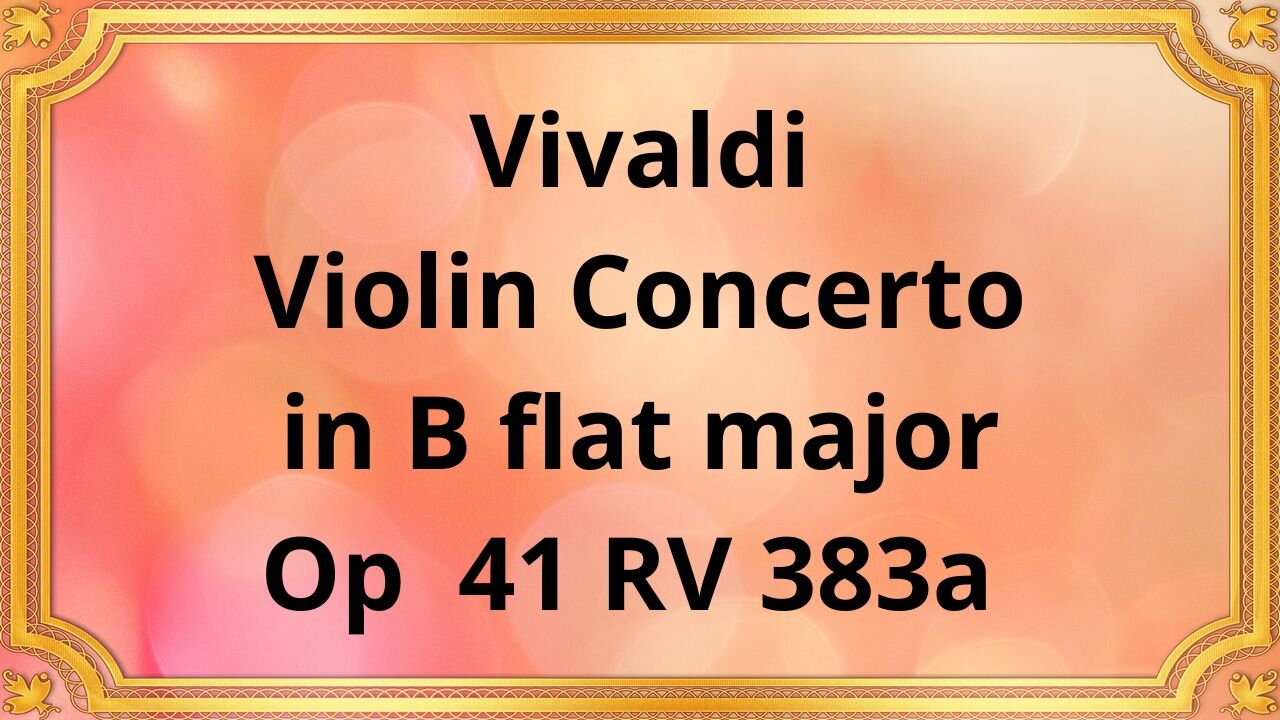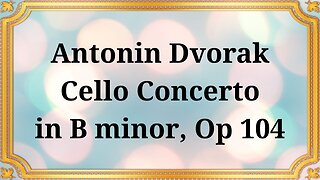Premium Only Content

Vivaldi Violin Concerto in B flat major, Op 41 RV 383a
Vivaldi's Violin Concerto in B Flat Major, Op 41 RV 383a is a masterpiece of baroque music that has captivated audiences for centuries. Composed by Antonio Vivaldi, one of the most prominent Italian composers of the 18th century, this concerto is a shining example of the composer's mastery of the violin and his ability to create beautiful and expressive music.
The concerto is structured in three movements: Allegro, Largo, and Allegro. The first movement, Allegro, is a fast and lively piece that showcases the virtuosity of the soloist. The violinist's skillful use of the bow creates a mesmerizing effect that is both energetic and elegant. The second movement, Largo, is a slow and expressive piece that highlights the violin's lyrical qualities. The soloist's delicate phrasing and careful use of vibrato create a hauntingly beautiful melody that is both emotive and introspective. The final movement, Allegro, is a return to the high energy and technical proficiency of the first movement. The soloist's fingers fly across the fingerboard in a dazzling display of skill and dexterity, bringing the concerto to a rousing conclusion.
One of the most notable aspects of Vivaldi's Violin Concerto in B Flat Major, Op 41 RV 383a is the composer's use of harmonies and counterpoint. Vivaldi was known for his mastery of these techniques, and this concerto is no exception. The intricate interplay between the soloist and the accompanying orchestra creates a rich and complex musical landscape that is both engaging and satisfying to the ear.
In terms of technical difficulty, the concerto is quite challenging for the soloist. The fast runs, intricate arpeggios, and demanding bowing techniques require a high level of skill and proficiency. However, the end result is a piece of music that is both technically impressive and emotionally moving.
Overall, Vivaldi's Violin Concerto in B Flat Major, Op 41 RV 383a is a stunning example of baroque music that continues to captivate audiences today. Its intricate harmonies, complex counterpoint, and demanding technical requirements make it a challenging but rewarding piece for both the performer and the listener.
1. Allegro 00:00
2.Largo 03:36
3.Allegro 07:12
-
 36:29
36:29
Classical music_Music Inspiration
1 month agoAntonín Dvořák Cello Concerto in B minor, Op 104
681 -
![STILL. LASERING. EVERYTHING. | splitgate2 | [6-21-25]](https://1a-1791.com/video/fww1/4e/s8/1/d/P/p/V/dPpVy.0kob-small-STILL.-LASERING.-EVERYTHING.jpg) LIVE
LIVE
HEXIK
4 hours agoSTILL. LASERING. EVERYTHING. | splitgate2 | [6-21-25]
48 watching -
 7:26
7:26
GBGunsRumble
12 hours agoGBGuns Armory Ep 143 BRG 9 Elite Gen 2
11.6K2 -
 LIVE
LIVE
FyrBorne
11 hours ago🔴Warzone Sniping: How To Pick YOUR Perfect Sniper Support
21 watching -
 2:16:18
2:16:18
Side Scrollers Podcast
19 hours agoCONTENT NUKE GOES LEGAL, AI To REMAKE Classic Movies, Walter Day Interview | Side Scrollers Live
26.7K5 -
 LIVE
LIVE
Lofi Girl
2 years agoSynthwave Radio 🌌 - beats to chill/game to
108 watching -
 40:40
40:40
ZeeeMedia
20 hours agoDARPA's Next Planned Pandemic Revealed? ft. Jon Fleetwood | Daily Pulse Ep 51
33.2K17 -
 5:54
5:54
Zach Costello
2 days agoMedia CAUGHT Editing Tulsi Gabbard Clip TO TRAP Trump
44.9K17 -
 2:14:39
2:14:39
Badlands Media
16 hours agoThe Liberty Den Ep. 147: Truth Bombs, Shadow Games & Signs of the Shift
430K30 -
 13:15:25
13:15:25
GritsGG
18 hours agoQuads Win Grind!! 👑 2587+ Ws
135K11